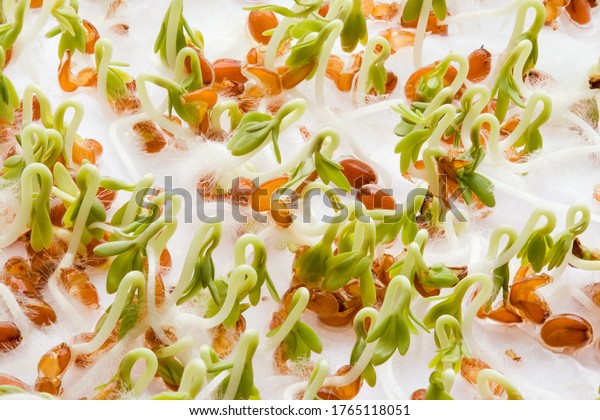Germinating Seeds in Cotton Wool: A Fun Science Experiment
Embarking on a journey through the world of botany can be a rewarding experience, especially when it involves a simple yet educational activity like germinating seeds in cotton wool. This fascinating experiment serves not only as a gateway to understanding plant biology but also as an engaging way to introduce children and novice gardeners to the delicate art of seed germination. Below, we will delve into the various aspects of this experiment, provide a step-by-step guide, and explore the science behind it.
Understanding Seed Germination
To grasp the significance of germinating seeds, one must first understand the fundamental process involved. Germination is the phase where a seed develops into a new plant. Typically triggered by environmental factors such as moisture, temperature, and light, germination is a remarkable transformation. Seeds undergo metabolic changes that activate and awaken their dormant cells, leading to the emergence of a sprout.
During germination, crucial physiological processes occur. The seed begins to absorb water—this is known as imbibition. Once imbibition commences, enzymes become activated, breaking down stored nutrients in the seed, which fuels the initial growth of the seedling. The germination process culminates in the sprouting of the radicle, which will grow into the root system, followed by the emergence of the cotyledons, the first leaves of the plant.
Choosing the Right Seeds
Not all seeds are equal, and some are more suited for the cotton wool germination experiment than others. Selecting the right type of seeds is essential for achieving successful results. Fast germinating seeds such as beans, peas, and radishes are excellent choices due to their relatively quick sprouting times and ease of handling.
When choosing seeds, consider the following:
- Viability: Ensure the seeds are fresh and have not expired.
- Size: Smaller seeds may be easier to handle and observe in a simplified environment.
- Type: Opt for seeds that are known for their robust germination rates and adaptability.
This thoughtful selection process will enhance the likelihood of successful germination, enabling participants to witness firsthand the captivating journey from seed to sprout.
Materials Needed for the Experiment
A successful seed germination experiment requires a few basic materials:
- Cotton Wool: This provides an absorbent and sterile environment for the seeds.
- Seed Varieties: Choose your preferred seeds from the previously discussed options.
- Plastic Containers: Shallow trays or clear plastic cups are ideal for visibility and drainage.
- Water: It’s essential for initiating the germination process.
- Labels (Optional): Consider labeling containers to track different seed varieties.
With these materials in hand, participants can embark on their journey of discovery. The setup is straightforward and requires minimal preparation.
Step-by-Step Guide to Germinating Seeds in Cotton Wool
Executing this experiment is relatively easy and can be completed within a few simple steps:
Step 1: Begin by preparing the cotton wool. Tear pieces of cotton wool and place them in the base of your plastic container, ensuring they are densely packed but still allow for air circulation.
Step 2: Moisten the cotton wool with water. It’s crucial not to oversaturate it; the cotton should be damp but not dripping wet. Proper moisture levels are essential for germination.
Step 3: Evenly distribute your chosen seeds on top of the damp cotton wool. To enhance visibility, space them out by at least a half inch (1.25 cm) apart.
Step 4: Lightly cover the seeds with a thin layer of additional cotton wool. This helps maintain moisture and warmth—both critical components for successful germination.
Step 5: Place the container in a warm, bright location, but not in direct sunlight, as excessive heat can hinder the germination process. Monitor the moisture levels regularly, ensuring that the cotton wool remains damp.
Observing the Fascinating Process
Patience is key in this endeavor. Most seeds will begin to germinate within a few days, although certain varieties may take longer. Throughout this period, encourage participants to observe changes daily. Take notes or capture photographs to document the development stages of each seedling.
As shoots emerge, they will provide a clear visual of the miraculous transformation occurring. Not only does this engage one’s sense of curiosity, but it also presents a plethora of learning opportunities about plant biology, life cycles, and the importance of observation in scientific pursuits.
Conclusion: The Significance of Seed Germination
The process of germinating seeds in cotton wool is more than just a fun experiment; it fosters an appreciation for the natural world and educates about the critical role plants play in our ecosystem. Understanding germination encapsulates fundamental biological principles while nurturing a sense of responsibility for the environment.
Whether conducted in a classroom setting or at home, this experiment inspires individuals to cultivate a lifelong interest in horticulture and the sciences. Each sprouted seed serves as a reminder of life’s potential and the wonders of growth, opening new avenues for exploration and understanding in the vast field of botany.





Leave a Comment